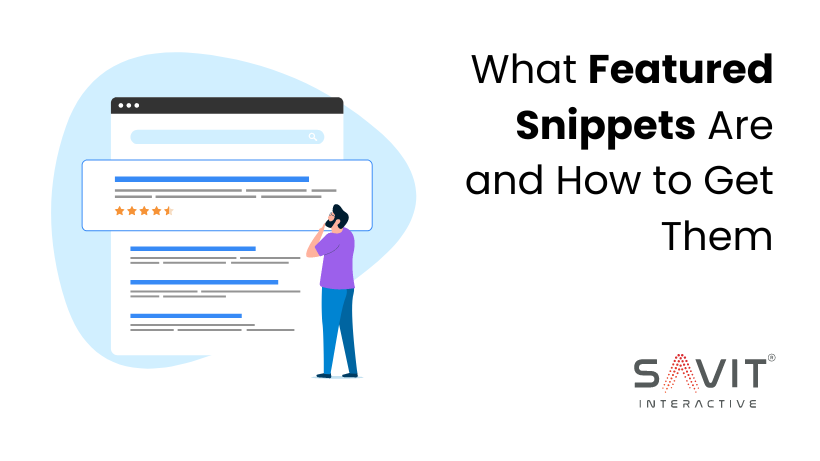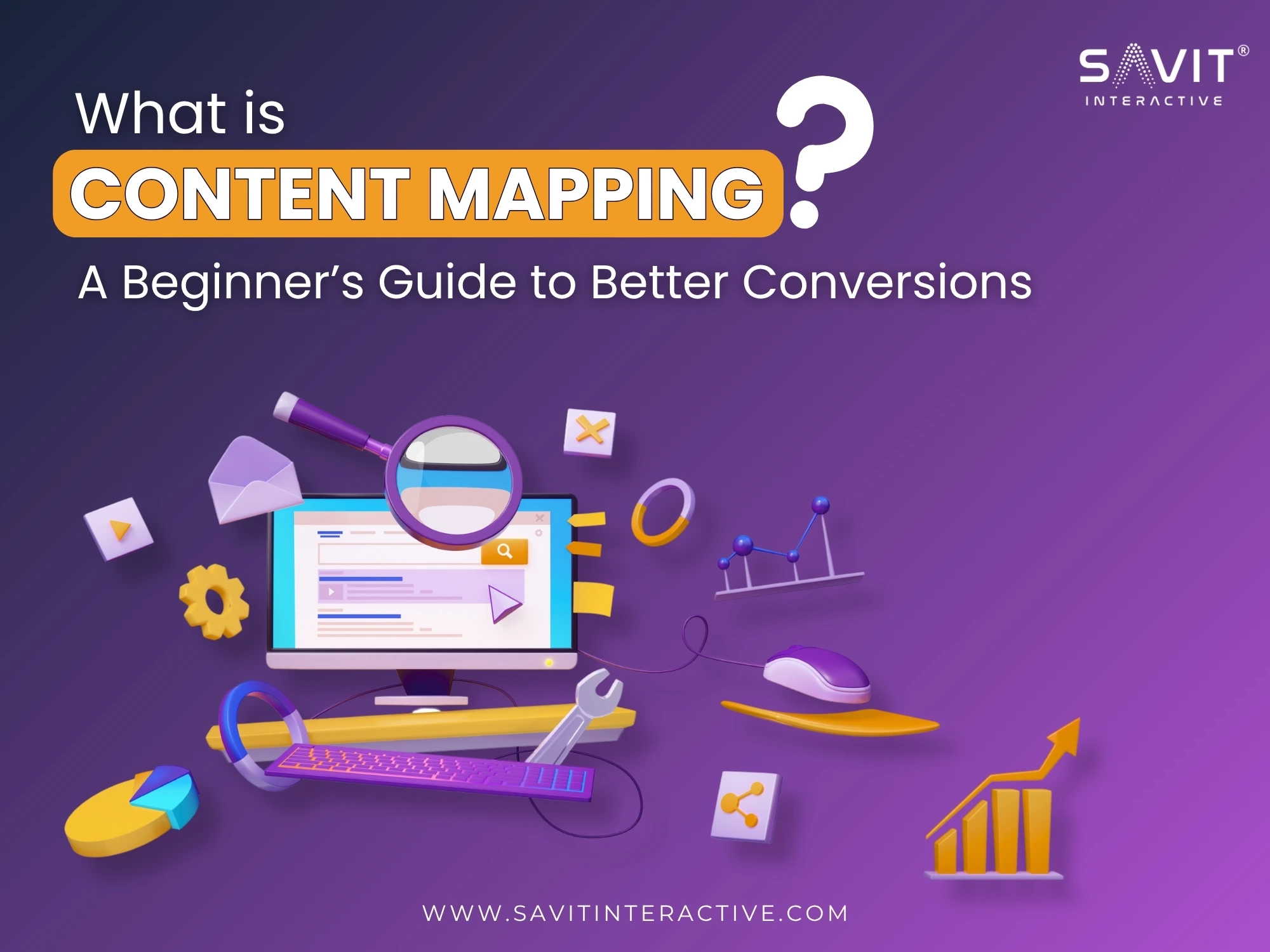Google has evolved beyond merely presenting links in response to search queries. The top results are now filled with handy features centered around helping search users find an accurate, concise, and, at times, systematically organized answer to their questions.
Google has showcased its consistent committed towards assisting users in finding answers to their questions efficiently and in a time-saving manner by introducing features such as –
- People also ask:- a SERP feature that provides users with additional questions related to their original search query and quick answers to them.
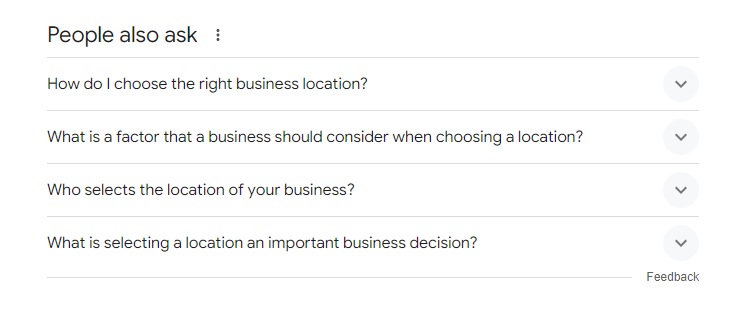
- Knowledge Graph:- The Knowledge Graph utilizes its extensive database to consolidate relevant information in a single space or one could call it – a box. This box highlights the most valuable details regarding entities like organizations, individuals, locations, or objects in the Knowledge Panel.
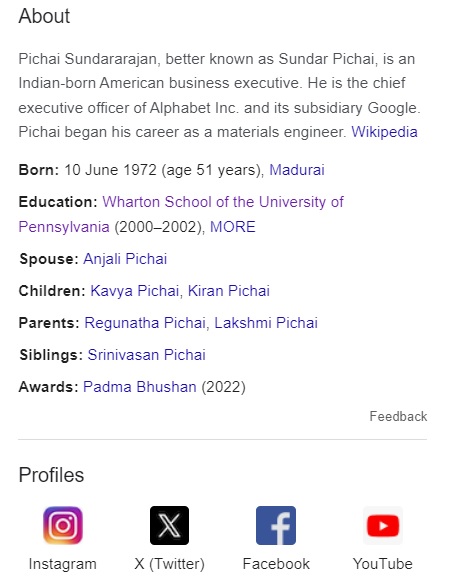
And finally, let’s talk about one of the most distinctive and renowned features in the SEO market – the “Featured Snippet“.
Understanding the Concept of Featured Snippets
A featured snippet is the highlighted box that appears at the top of Google search results. It contains a condensed piece of information extracted from a website deemed relevant by Google to answer your search query.
Positioned just above the conventional organic search results, it swiftly provides an answer without necessitating a click-through to a website, hence earning its nickname “Position Zero.”
Featured snippets are derived from search results on the web. Google’s automated systems evaluate if a webpage is suitable to be showcased as a featured snippet in response to a particular search query. They generally appear in the following forms:
1. A two-to-three liner response offering definitive answers
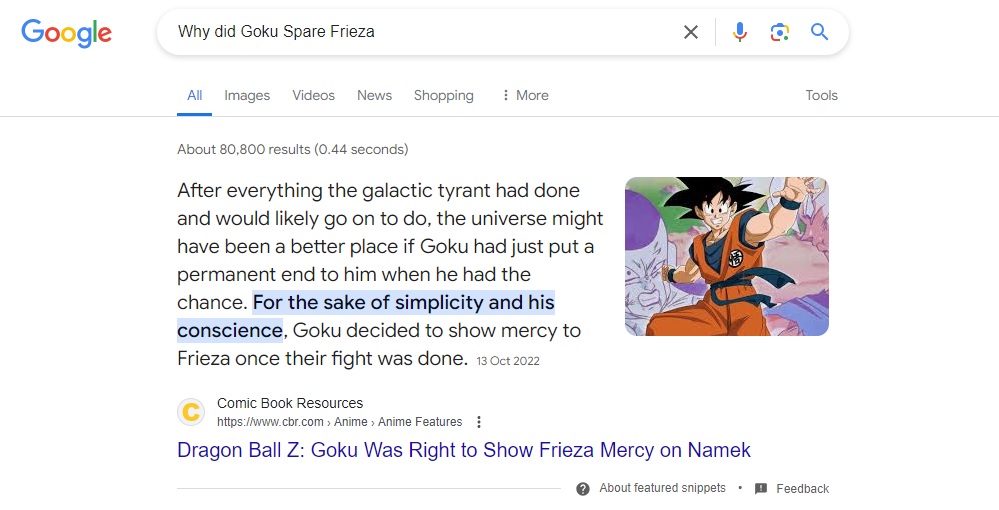
2. An organized list that serves as condensed summaries or step-by-step guides for queries with informational intent.
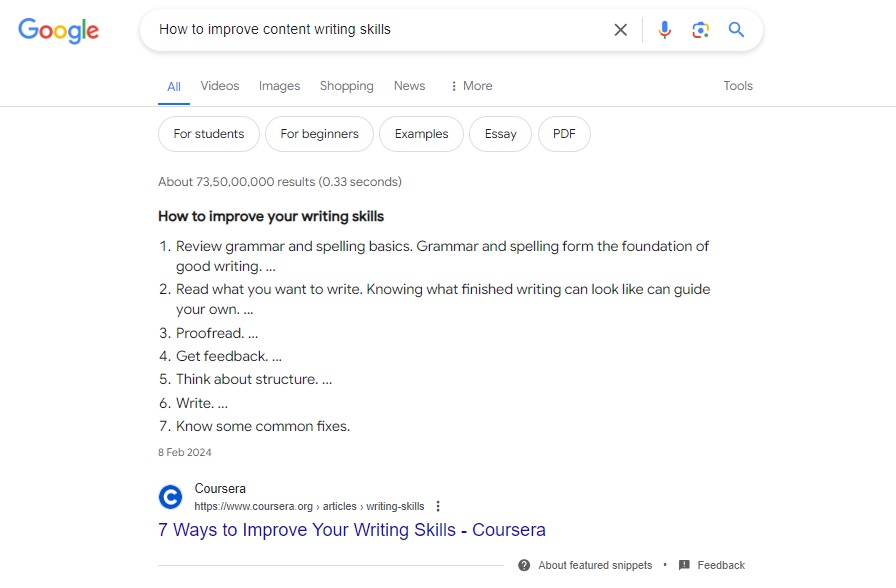
3. Organized data charts

4. Direct video links from platforms such as YouTube and Facebook, offering comprehensive explanations for informational or long-form search queries.
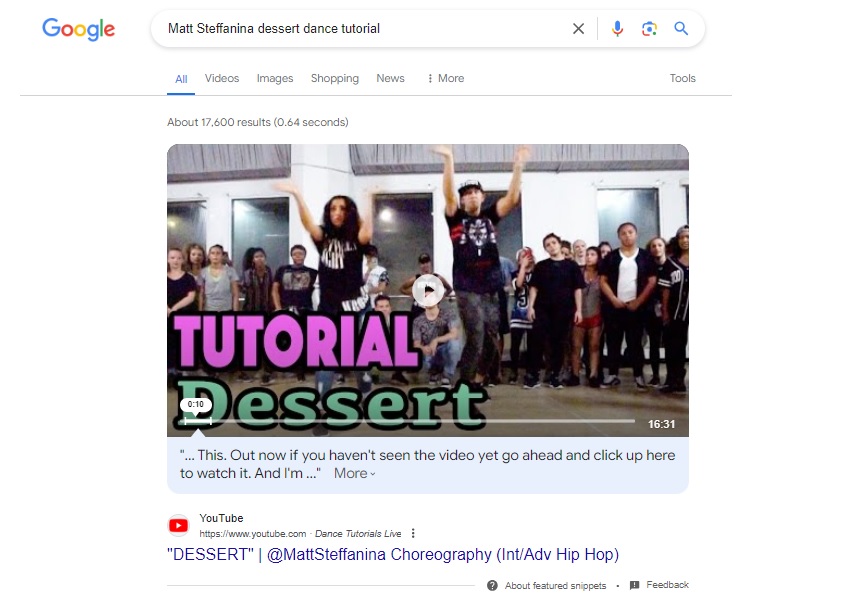
Importance of Featured Snippet
Ever since google introduced their feature snippet function, browsing for information you seek has never been easier, solidifying its position as the top search engine.
Here’s how feature snippets benefit both search users and website owners:
- Improved User Experience: Feature snippets offer users quick and to-the-point solutions to your queries, right on the search results page. This means users can get the information they need without having to sift through numerous links, saving them time and effort, which in turn boosts user experience.
- Increased Relevance: Google strives to deliver the most relevant information for each search query. These snippets showcase Google’s algorithm’s ability to comprehend the context and intent behind user queries, resulting in more accurate and pertinent answers. This emphasis on relevance enhances the overall search experience, aligning with Google’s goal of delivering the most helpful and precise results to users.
- Enhanced Visibility for Websites: Websites that are featured in snippets enjoy greater visibility in search results. Even if users don’t click through to the website, the snippet still provides valuable exposure and branding for the site, ultimately driving more traffic and engagement.
How to Find Featured Snippet Opportunities
Feature snippets have sparked a race among website owners to boost their visibility in search results. This has intensified competition between Search Engine Optimization Companies in USA in terms of content creation and SEO strategies, resulting in the delivery of more valuable content to target audiences.
Now being a business owner, you wouldn’t want to miss out on this possibility of achieving ‘position zero’ for increased organic traffic on your website. Where do you start from? Like any other SEO attempt whether you are a business owner or an SEO company in USA, the process starts from picking your targeted keyword.
Preferably the keyword should have the following phrases:
- “What is” example: – What is the employment rate in Ohio?
- “How to” example: – How to pay my credit card bill?
- “Why should One/We/I” example: – Why should we work out early in the morning every day?
As feature snippets serve as direct responses to user inquiries, you have a better chance to rank on question-based search queries.
Now take advantage of these keywords to check your website’s current ranking. Remember, you don’t have to be in the top two positions on a search engine results page (SERP) to secure a featured snippet. Being within the top five positions also counts.
If your website ranks in the top 5, it’s a clear sign that you’re on the right track to nab those coveted featured snippets. Safe to say that it’s time to buckle down and start optimizing both your content and your website to maximize your chances.
But if you are ranking below that, focusing on improving your SERP ranking should be your primary goal before targeting featured snippet. The main reason is – credibility. Even though the featured snippet showcases the best answer to a search query, Google will only recognize you as credible if you have a solid ranking.
And what’s the biggest parameter for credibility in the SEO world? Your search engine ranking!
How to optimize content for featured snippets
Once you’ve determined if targeting feature snippets aligns with your strategy, it’s time to optimize your content for optimal chances of snagging one.
Just a heads-up before we dive in => Your website content has the potential to snag a featured snippet from various sources. Whether it’s your homepage, service pages, a snippet from a blog post, or even your FAQ section – there are plenty of opportunities to boost your site’s visibility and attract more organic traffic.
Step 1: Research Queries that Trigger a Featured Snippet
Even though the steps remain consistent, it’s time to put yourself in the shoes of your potential customers. Your target keyword should be closely tied to your industry and the material you regularly post on your site.
Let’s say you’re a business owner managing a TV repair shop. You’ve already achieved a strong position on search engine results pages (SERPs) thanks to effective SEO tactics (like well-optimized service pages) and content marketing efforts (such as blog posts addressing common TV issues your audience faces).
But now that you want to target feature snippets, you need to identify the type of content in your niche that typically triggers a feature snippet for specific search phrases.
For example,
1. Search query – “What could be causing the flickering broadcast on my TV?”
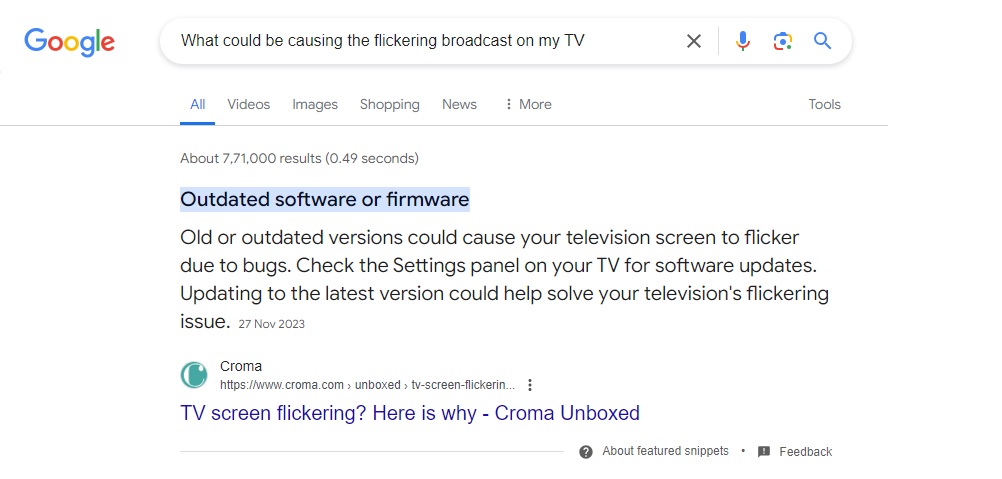
Check out the response in the image above. It gives a quick overview of the most prevalent reason behind the issue mentioned in the search query. Your goal now is to craft a more informative and concise answer that surpasses the existing featured snippet.
However, don’t let this divert your attention from the prerequisite condition of writing a blog with a structured outline. Why? Well, here’s a surprise waiting for you:
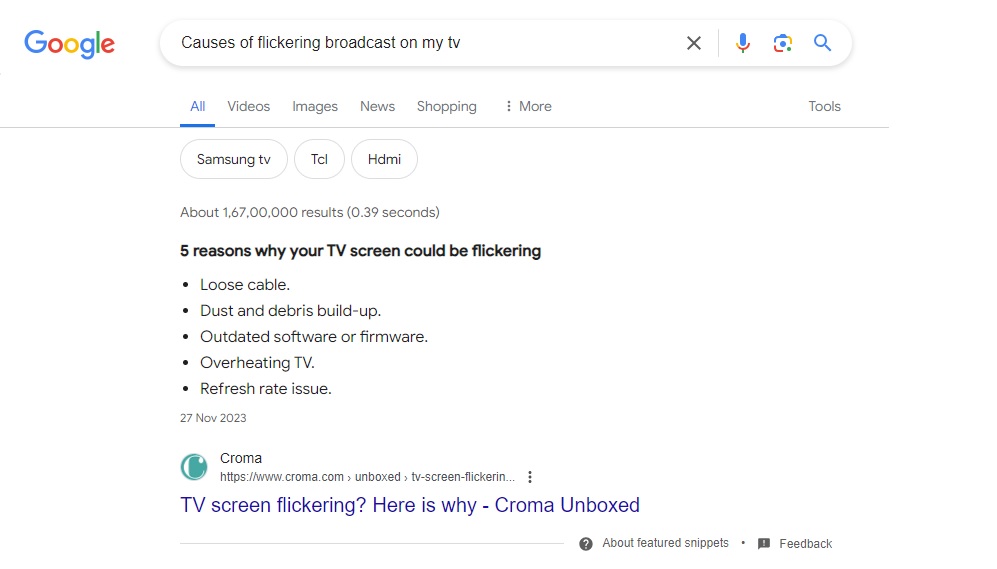
We simply adjusted the search query while keeping the same goal: figuring out why the TV screen is flickering. The outcome? Another featured snippet popped up, presented in a list format. When you visit this blog, you’ll see the same list, but with each point explained in depth, using real-life scenarios.
What you can learn from this example is that – similar search terms can sometimes yield different types of featured snippets. That’s why it’s crucial not to sacrifice the quality of your blog’s structure for crispness. Provide detailed descriptions and let Google’s algorithm handle the screening process.
No matter if a passage from your content or blog outline triggers a featured snippet, if it happens, it happens. Just concentrate on delivering fast and digestible solutions to your target audience.
After conducting thorough research on the specific keywords you’re targeting, you move on to the second step.
Step 2: Optimize and Structure Content to Answer Questions
Continuing from the above example of the TV repair business, at this stage, the owner has finalized their targeted keyword and the search phrases they want to appear on. The semantics used in their content featuring the keyword should sound like an “answer” to the query.
When it comes to content marketing where you post blogs, articles, or guest posts to boost your visibility, prioritize structuring the answers in the most sophisticated manner possible. Ideally follow this guideline:
- Title Tags: Include your target keyword and a common problem you’re solving. Helps both the search engine and the user understand the context of your content.
- Subheads: Google often uses subheads for featured snippets. They might pull subheads (<h2> through <h6>) and list them in order. This is handy for searches looking for certain procedures or how-to guides.
- Body Copy: For “what is” questions, put your answer in a <p> tag right after the question header. Keep it between 50 and 60 words.
Step 3: Use Schema Markup
Although schema markup won’t directly impact the reading experience of our targeted search engine users, the fate of our feature snippet is at the mercy of Google’s algorithm.
To optimize your website for Google’s algorithm, it’s crucial to use schema markup. This helps Google’s crawling bot comprehend the context of your content across your webpage.
There are various kinds of schema markup for different purposes:
- Local Business Schema Markup: Most SEO Services for Local Business providers use this tool on their service pages to provide structured data about the business’s location, contact information, and services offered.
- Event Schema Markup: Implemented to provide structured data about events, including details such as event name, date, location, and organizer information.
- Breadcrumb Schema: Utilized to create a hierarchical navigation trail on web pages, enhancing user experience and providing search engines with clear site structure.
- Article Markup: Applied to indicate the content of a webpage as an article, providing structured data such as headline, author, publication date, and main content body.
- FAQ Page Markup: Used to mark up frequently asked questions (FAQs) on a webpage, providing structured data to help search engines display relevant FAQ snippets in search results.
As Google rigorously scours the web for content to showcase in their snippets, it’s beneficial to help them comprehend your content.
Incorporating relevant schema markup into your content aids Google in recognizing your intended audience and linking them to your content by boosting your visibility for targeted search phrases. And if your content stands out as the best among competitors, congratulations! You may now have a coveted feature snippet attributed to your site.
- Another tip:
When you’re marking up your articles with schema codes, make sure to include the rel=”publisher” tag. This tells Google that your content is associated with a credible source—where you got your information from. Google tends to favor authoritative and trusted websites, so acknowledging them in your schema code can boost your credibility.
How to Optimize for Different Snippet Types
While there is no hard and fast method to earn a featured snippet accurately, there are things you can do to ensure Google considers your content to be the best response to the queries you are targeting. Aligning your answer to the feature snippet type you are competing against is one of them.
- Paragraphs Snippet
If you want your content to appear as a paragraph snippet on Google, start by including a relevant heading that matches the user’s query. Keep your answer concise, aiming for under 300 characters. (about 50 words is ideally preferred). Most importantly, your response should be accurate, informative, and free of any typos or grammatical mistakes.
Try including a relevant photo in the answer for better visibility. Answer with a descriptive image helps in explaining the context of its matter addressed, and gains more points in the eyes of google.
- Tables Snippet
While competing against a table snippet, it’s best to include an actual table within your content. Make sure it’s properly formatted with accurate information, providing users with a clearer understanding compared to the current top-ranking result. And don’t forget to use a heading to describe what set of data it contains.
- List Snippet
Once again, headings are important for this type of snippet. But it doesn’t mean the entire list needs to appear in its entirety under a single heading.
(For SEO execs: trying to interlink the image URL of the image I have used for the mentioned search query)
Headers are crucial for appearing in list snippets. However, it’s not necessary to display the entire list under one header. Take, for example, the question “Causes of flickering broadcast on my TV?” When you click the link, you’ll notice detailed explanations under each header. But in the featured snippet, only the headers are shown.
This happens because Google decides that users don’t need specific data about each header that lists the possible reasons for TV screen flickering. If Google believes your headers effectively answer the search query, they’ll feature them in the form of a list snippet.
- Videos Snippet
If you’re running a business with a website and a YouTube channel, make sure your content matches what your audience is looking for and helps them out. Share useful stuff related to your niche on your website (like blog posts) and on YouTube (like how-to videos).
For instance, when you search for “How to Jog properly,” you might see a video snippet right at the top of the search results. How did that happen? Well, even a simple topic like jogging can get featured if it’s done right.
When your video fits well with what people are searching for and provides helpful info, Google takes notice.
If your video has clear voice-over narration, Google can even pick out the best bits to show in search results.
So, going back to the jogging example, if your video explains jogging techniques clearly and addresses common problems, Google might put it at the top spot, making it easier for people to find.
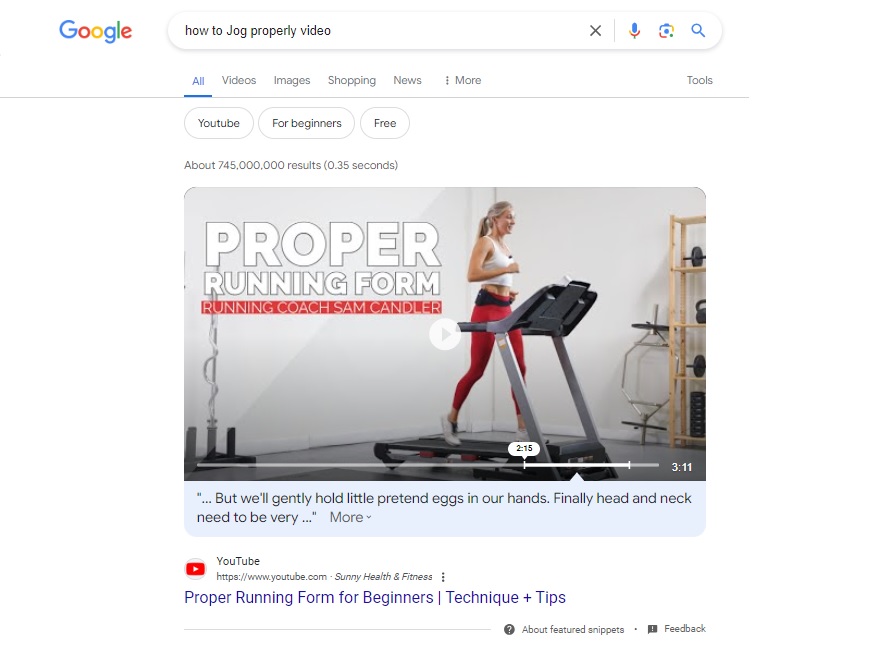
Bottom Line:
When you make your content suitable for featured snippets, you’re not just trying to rank higher in search results. You’re also improving the overall quality of your content in the long run. This improved content quality helps you connect more effectively with your audience, which in turn boosts your conversion rates.
Here’s the step-by-step progression of your feature snippet journey:
- Start with quality content
- Aim for a featured snippet
- Watch as organic traffic increases
- Enjoy high engagement from your audience
- Experience a surge in conversion rates
- See your business revenue soar
- Over time, that can lead to better business results
But again, getting your content to appear as a featured snippet on Google takes a lot of trial and error. You have to use SEO tools to understand how Google sees your content, then make changes accordingly. Keep doing this until you get the featured snippet spot. And if you don’t have the required time or motivation for this task, you can trust Savit Interactive to handle it for you!
Our Search Engine Optimization services in USA have proven to be beneficial for numerous businesses across different states and diverse industries. Let us leverage this amalgamation of practical knowledge for your online venture!
